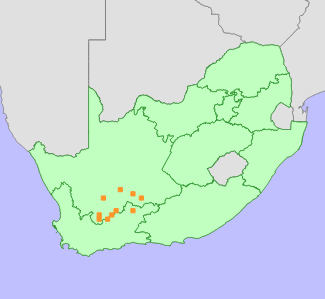|
Scientific Name | Stomatium suaveolens Schwantes |
Higher Classification | Dicotyledons |
Family | AIZOACEAE |
National Status |
Status and Criteria | Least Concern |
Assessment Date | 2019/11/03 |
Assessor(s) | D. Raimondo |
Justification | Stomatium suaveolens is a widespread species endemic to the Karoo. It has an extent of occurrence (EOO) of 29 906 km², and is known from 10 collection localities but highly likely to be undercollected. It is not suspected to be declining is therefore listed Least Concern. |
Distribution |
Endemism | South African endemic |
Provincial distribution | Northern Cape, Western Cape |
Range | This species is endemic to South Africa, and is found from Calvinia to Sutherland, Williston to Fraserburg and Victoria West. |
Habitat and Ecology |
Major system | Terrestrial |
Major habitats | Eastern Upper Karoo, Northern Upper Karoo, Western Upper Karoo, Roggeveld Shale Renosterveld |
Description | It grows in shallow pans. |
Threats |
| Its habitat is still mostly intact, it is experiencing some degradation of habitat from livestock overgrazing but with many recent collections and no intensification of grazing in the Karoo over the past 15 years, grazing is not suspected to be causing significant decline to the population.
Large-scale shale gas fracking was proposed in 2015 for the Karoo basin covering the majority of this species' range. Subpopulations on flats would be most vulnerable to habitat loss to infrastructure development related to fracking, and this species could decline in future if fracking goes ahead. A Strategic Environmental Impact Assessment submitted to South Africa's Department of Environmental Affairs in 2016 cautioned against moving ahead with Shale Gas fracking based on the very high infrastructure costs associated with fracking as well as multiple secondary negative impacts both to biodiversity and other economic activities in the region. Furthermore geological studies that have taken place since 2016 have found that gas deposits are not as substantial as original suspected due to the very old age of the Karoo shale formations and the fact that the extensive number of dolerite intrusions throughout the Karoo have resulted in much of the gas being lost. At present, future development scenarios are too uncertain to estimate the potential extent of the impact on the population but it is unlikely that shale gas fracking will proceed in the near future. |
Population |
It is noted as locally common from some of the herbarium collections.
|
Population trend | Stable |
Assessment History |
Taxon assessed |
Status and Criteria |
Citation/Red List version | | Stomatium suaveolens Schwantes | Least Concern | Raimondo et al. (2009) | |
Bibliography |
Magee, A.R. and Boatwright, J.S. (eds). In prep. Plants of the Karoo: A Conspectus of the Nama-Karoo and Adjacent Summer-Rainfall Regions of the Northern and Western Cape Provinces. Strelitzia.
Raimondo, D., von Staden, L., Foden, W., Victor, J.E., Helme, N.A., Turner, R.C., Kamundi, D.A. and Manyama, P.A. 2009. Red List of South African Plants. Strelitzia 25. South African National Biodiversity Institute, Pretoria.
Snijman, D.A. 2013. Plants of the Greater Cape Floristic Region 2: The extra Cape flora. Strelitzia 30. South African National Biodiversity Institute, Pretoria.
|
Citation |
| Raimondo, D. 2019. Stomatium suaveolens Schwantes. National Assessment: Red List of South African Plants version 2024.1. Accessed on 2025/11/23 |
 Comment on this assessment
Comment on this assessment


